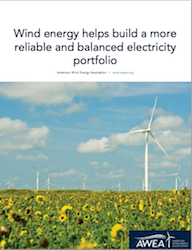According to a new report released today by the American Wind Energy Association (AWEA), adding more wind power to the U.S. electric grid can help the country meet the goals set out in the Environmental Protection Agency’s (EPA) Clean Power Plan. Carbon emissions will be reduced and the lights will stay on, said AWEA, as wind power is already providing clean and reliable power for millions of Americans.
“Americans want energy security, clean air, and a more reliable energy system,” said AWEA CEO Tom Kiernan. “Diversifying our energy mix with wind helps us achieve all of these goals at once.”
During a press webinar this morning, AWEA Senior Director of Research Michael Goggin walked through the several of the most common questions about wind power and readability that are answered in the report. The report focuses on the 15 most common questions and provides answers drawing on the expertise of grid operators along with other research.
 Goggin explained that as wind energy has grown to provide a larger share of our electricity mix, wind turbine technology has matured so that modern wind plants are able to provide the same grid reliability services as conventional generators. Changes in wind output are not a major issue for grid operators because all power plants are already backed up by all other power plants, and grid operators already deal with large fluctuations in electricity supply and demand. In fact, the gradual and predictable changes in wind power are also much easier for grid operators to address than the large-scale outages that can occur at conventional power plants.
Goggin explained that as wind energy has grown to provide a larger share of our electricity mix, wind turbine technology has matured so that modern wind plants are able to provide the same grid reliability services as conventional generators. Changes in wind output are not a major issue for grid operators because all power plants are already backed up by all other power plants, and grid operators already deal with large fluctuations in electricity supply and demand. In fact, the gradual and predictable changes in wind power are also much easier for grid operators to address than the large-scale outages that can occur at conventional power plants.
“Based on grid operators’ experience with reliably and cost-effectively integrating very large amounts of wind energy, wind can play can play a key role in meeting EPA’s Clean Power Plan,” said AWEA Senior Director of Research Michael Goggin.
Real-world examples presented in the report help illustrate the significant role wind energy is already playing including in Texas when fossil-fired power plants failed in the cold in February 2011, and more recently did so again across much of the U.S. during the “Polar Vortex” in early 2014.
According to Wind Vision, a new Department of Energy report due for release in early 2015, will show that wind could double from today’s amount to reliably supply 10 percent of the nation’s electricity demand by 2020, 20 percent by 2030 and 35 percent by 2050. However, as stressed by Kiernan during the presser, a long-term commitment to support wind energy by the federal government through programs such as Production Tax Credit will be critical to meeting the goals set forth in the Clean Power Plan as well as the President Obama’s climate change objectives.
Click here to read the full report.

